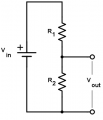You need to try and do the reverse engineering yourself.
LM339 is a quad analog comparator that outputs to four LEDS.
There will be five resistors in series. Try to draw these five resistors and label the values.
All you will need to do is identify the top resistor and then change that (or add another resistor in parallel) to change the range from 36V to 24V.
The circuit will be similar to this:

LM339 is a quad analog comparator that outputs to four LEDS.
There will be five resistors in series. Try to draw these five resistors and label the values.
All you will need to do is identify the top resistor and then change that (or add another resistor in parallel) to change the range from 36V to 24V.
The circuit will be similar to this:














